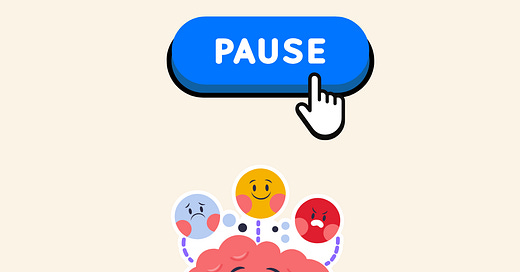What Is Emotional Attunement?
Emotional attunement means tuning in to your emotions and body signals with curiosity, not criticism. It’s noticing what you feel—without pushing it away, masking it, or judging yourself—and responding in ways that honor your needs.
For ADHD women, this can be especially powerful because so many of you were taught to dismiss or override your emotions to fit in, be accepted, or appear “productive.” Emotional attunement helps you rebuild trust with yourself.
Emotional Attunement: Listening Without Judgment
Emotional attunement means noticing your emotions and body signals—and responding to them without judgment or suppression.
Many women I work with initially respond to their emotions with frustration, avoidance, or masking.
If that’s you, know that it’s completely understandable—and incredibly common for ADHD women.
You were likely not taught to listen to your emotions or be curious about their importance. Instead, you were probably shamed for being "too much" or "too sensitive" and learned to hide or dismiss how you felt just to get through the day.
But emotional attunement offers a different path.
It invites you to:
🔍 Notice Feelings Instead of Ignoring Them
Attunement begins with noticing emotions like anxiety, overwhelm, or even excitement—and asking, What are you trying to tell me?
Think of emotions as messengers or dashboard indicators. They're not the problem—they're pointing to something that matters. When you tune in, you’re more likely to respond in ways that are useful, protective, and compassionate.
🗣️ Name and Honor Your Feelings
Naming your emotional experience is often the first step toward self-support. A simple pause—a body scan, a moment to ask “What am I feeling right now?”—can open the door to meaningful care. Honoring what you feel, even when it’s uncomfortable, helps build emotional safety and trust with yourself.
✅ Validate and Explore Supportive Responses
Instead of battling your feelings, attunement helps you validate them and explore accommodations that make sense for your nervous system.
For example:
If you feel anxiety rising in a loud, crowded grocery store, an attuned response might be to move to a quieter aisle, wear noise-reducing headphones, or take a moment to regulate your breath.
Recognize Patterns That Lead to Wise Choices
With regular emotional check-ins, you may begin to notice patterns. You might realize that your irritability spikes when you skip meals, or that you crash after too many back-to-back meetings. These patterns are important. They shift emotions from feeling random or overwhelming to becoming clear signals with actionable meaning.
Even if the answer isn’t immediately obvious, the habit of tuning in builds emotional clarity and strength over time.
Why This Matters
Emotional attunement doesn’t get rid of difficult feelings, but it helps you respond to them in ways that feel grounded and kind. Many ADHD women find that when they begin to practice this, their emotions lose some of their intensity and they feel more regulated. Instead of reacting with fear or shame, they begin to respond with curiosity and care.
This shift can:
Increase your ability to self-accommodate
Reduce emotional reactivity and burnout
Deepen your self-trust and self-compassion
Lay the groundwork for lasting mental and sensory well-being
When emotions are treated as valid information instead of obstacles, healing becomes more sustainable, and self-compassion becomes more accessible.
I teach and practice emotional attunement inside the Flourish Program as part of the Self-Empowerment Model I’ve developed for ADHD women. It’s a foundational skill that supports everything else, because you can’t care for yourself if you ignore what you feel.
💌 Free 6-Step Guide
If emotional attunement sounds like something you want to learn more about, I’ve created a free step-by-step guide just for you.
I’m Kristen McClure, MSW, LCSW—a therapist with 30 years of experience, a child and mental health advocate, and a neurodivergent-affirming coach. I run a therapy practice in Charlotte, NC, and have developed a comprehensive, neurodivergent-affirming program for ADHD and AuDHD women.
🔹 Learn more about the Flourish program: here
🔹 Join the waitlist for the next Flourish cohort: here
🔹 Join my free, affirming community for neurodivergent women: here
🔹 Are you a therapist and want to learn about the flourish model? I’m considering teaching this model and sharing the materials. sign up here
I also write four free newsletters on Substack, covering ADHD advocacy, neurodivergent children, and therapist topics.
I hope you like this newsletter and the free resource I developed for you,
Have a nice week.
Warmly,
Kristen





I did something along these lines the other day when I could tell that I was extremely overstimulated and in hyperarousal. I went off some stuff I’ve learned over time but seeing it laid out like this and in the guide makes it so much clearer for me. This is something that I need more of which is why I responded to it so significantly. Will definitely be practicing this more especially when I am not in an actively stressed state too. That’s honestly when I always bring in my tools/skills. But I want to do more of this sort of thing even when I think I’m “fine.”